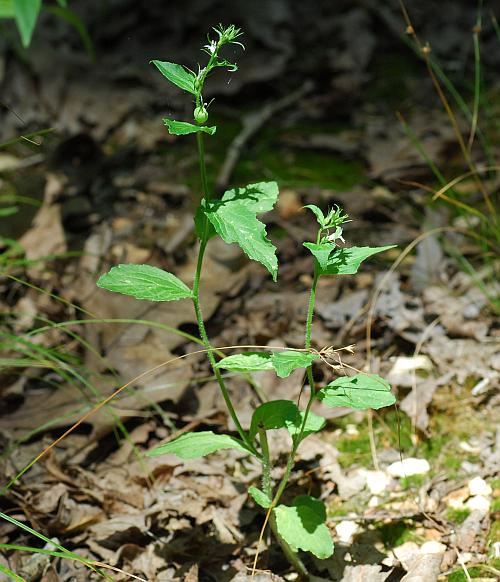Lobelia inflata L.
Indian Tobacco

Native
CC = 3
CW = 3
MOC = 66
© SRTurner
Lobelia inflata L.Indian Tobacco | |
 |
Native CC = 3 CW = 3 MOC = 66 |
© SRTurner |
|
Family - Campanulaceae Habit - Annual forb with taproot and fibrous roots, with milky sap. Stems - Ascending to erect, to 90 cm, unbranched or more commonly moderately branched toward the tip, not winged, moderately to densely pubescent with short, curved to more or less spreading hairs.
Leaves - Alternate, simple, sessile or with short winged petioles. Blades 2-11 cm long, 1.0-3.5 cm wide, reduced in the inflorescence, oblong-elliptic to elliptic, ovate, or obovate, the lowermost sometimes spatulate, tapered at the base, the margins finely to relatively coarsely and sometimes irregularly scalloped or bluntly toothed, the teeth with minutely whitened apicies, the upper surface glabrous or with sparse, more or less appressed hairs, the undersurface moderately pubescent with curved hairs.
Inflorescences - Terminal and axillary narrow racemes, the axis moderately to densely hairy, the bracts similar to the adjacent leaves toward the base, the upper bracts much shorter, each flower also with a pair of minute bracts immediately below the calyx. Pedicels to 3 mm long, puberulent, elongating in fruit to 6 mm.
Flowers - Resupinate, zygomorphic, bilabiate. Calyces 5-9 mm long, the tube 2-3 mm long at flowering, becoming noticeably enlarged and inflated as the fruit matures, the slender lobes 3-6 mm long, lacking auricles. Corollas 5-8 mm long, 5-lobed, white, sometimes bluish-tinged or with bluish purple lobes, the tube 3-5 mm long, without longitudinal slits, the lobes 2-3 mm long, the lower lip with a beard of dense hairs on the inner surface toward the base. Stamens 5, adnate at base of corolla tube. Filament tube 2-3 mm long, the anther tube 1.2-1.8 mm long. Style 3.5mm long, greenish, glabrous. Ovary 2-locular. Placentation axile.
Fruits - Ovoid inflated capsules 6-10 mm long. Seeds 0.5-0.8 mm long, ellipsoid, the surface with a series of minute pits and ridges, reddish brown.
Flowering - June - October. Habitat - Forests, streambanks, pond margins, pastures, fields, gardens, railroads, roadsides, moist, open, disturbed areas. Origin - Native to the U.S. Lookalikes - L. spicata. The difference is evident in plants with maturing fruits. Other info. - This small species is common throughout Missouri, and also across most of the eastern half of the continental U.S. except for far southern regions. It is recognized by its characteristic flowers, which are borne upside-down on the plant, and which have an evidently 2-lobed upper lip and 3-lobed lower lip. The plant is more branched than its lookalike L. spicata, and the inflated fruits are a dead giveaway. The species epithet inflata refers to the fruits. Photographs taken in Brown Summit, NC., 7-15-02 (DETenaglia); also at Crowley's Ridge Conservation Area, Stoddard County, MO, 7-17-2009, Glassberg Conservation Area, Jefferson County, MO, 8-7-2016, and near Labadie, Franklin County, MO, 8-18-2020 (SRTurner). |